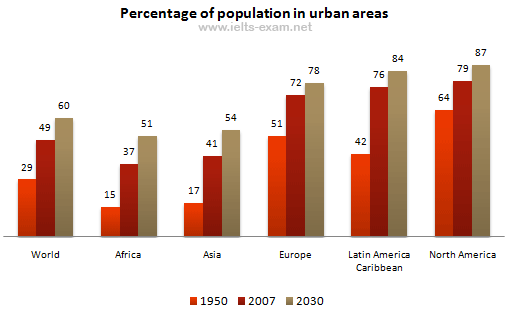You should spend about 20 minutes on this task.
The bar chart below gives information about the percentage of the population living in urban areas in the world and in different continents. Summarise the information by selecting and reporting the main features, and make comparisons where relevant.
Write at least 150 words.

Sample Answer 1
The bar chart shows the urbanization percentage of the world in 1950 and compares this with the percentage in 2007 and the projected percentage for 2030.
Between 1950 and 2030, the proportion of the world’s population residing in cities is expected to double, growing from 29% to 60%. However, this rate is less marked in some continents than in others.
For example, 64% of the population of North America was urban in 1950, increasing to 79% by 2007. By contra, just 15% of the African population was urban in 1950, which rose to 37% by 2007. This represents one of the highest urbanization rates in the world, even though the percentage of Africans in urban areas is still smaller than the world average.
It is also clear from the graph that urbanization in Latin America is projected to be higher than in Europe in 2030, despite being lower in 1950.
Sample Answer 2
The graph compares the growth in the percentage of the population living in urban areas in six different regions of the world.
According to the chart, between 1950 and 2007 the percentage of the population living in cities in Latin America and the Caribbean almost doubled, from 42% to 76%. In contrast, in Europe, it only increased by 21%. However, over half the people in Europe already lived in cities in 1950.
When we compare the projected increases in Asia and Europe by 2050, we see that in Asia, the percentage will continue to grow at the same speed, with a further increase of 25%. In contrast, in Europe, the change will be slower than before, increasing by only 12%. By 2050, the vast majority (around 90%) of people in Latin America, the Caribbean and North America will live in cities. More than half the population (62%) in Africa will live in urban areas by then.
Sample Answer 3
The column graph gives data on urban population growth in five different continents and the world in three different years, including the projection for the year 2030. Overall, the percentages of global city dwellers increased remarkably, and an excellent ratio of the world population will live in cities in the future.
As is evident from the illustration, less than one-third global population lived in urban areas in 1950. Most of these city-dwellers were in American and European continents, while only 15-17% of Asian and African were in municipalities. After 57 years, around half the global population lived in cities in Europe and America; this ratio went as high as eight out of ten. More than one-third of African lived in urban areas in this year, while it was slightly over 40% in Asia.
It is projected that six out of ten people will live in urban areas in 2030. This year, more than 8 persons in every ten in America would be city living population while almost the same ratio would prevail for the European city-dwellers. In Africa and Asia, more than half of the population will start living in different cities.
Sample Answer 4
The bar graph gives data on the number of people living in urban areas on different continents. The data are given for three different years, i.e. 1950, 2007, and 2030.
As is presented from the given data, initially, in 1950, on average, 29% of people in the world lived in urban areas. This year, the highest percentage of the population lived in urban areas in North America, which was 64%. In Africa and Asia, these percentages were the lowest (15 and 17 per cent, respectively). Half of the Europeans lived in urban areas, which was 42% in Latin America. After 57 years, in 2007, the percentage of the urban area population reached 49% of the world’s. North America again had the highest percentage of the population who lived in urban areas. The lowest percentage was in Africa (37%); in other continents, the percentages were around 40 to 70. The percentage of the population living in urban areas increased significantly in 2007 compared to the percentages in 1950.
It is projected that 60% of the world’s population will live in urban areas in 2030. This percentage would be more than 80 in both of the American continents. In Europe, this would increase to 78; in Asia and Africa, around half of their population would live in urban areas.
In summary, the percentage of people living in urban areas increased over time, and more and more people would live in urban areas over time.
